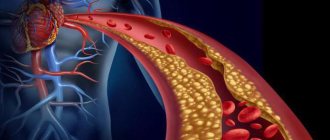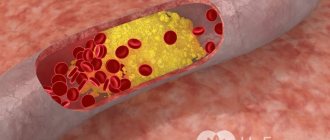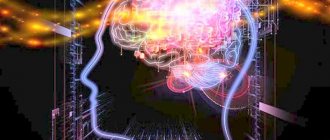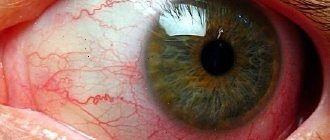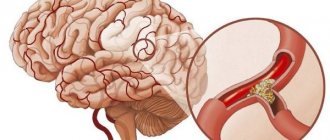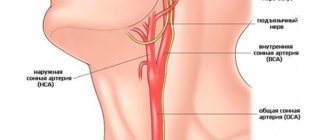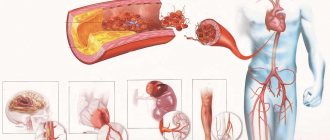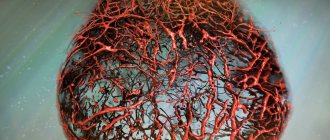Non-stenotic atherosclerosis is a pathology in which cholesterol plaques block the arterial lumen by less than 50.0%.
This is not an independent pathology, but a type of atherosclerosis. Many people 50 years of age and older know about non-stenotic atherosclerosis from personal experience.
The most common type of atherosclerosis is the BCA (brachiocephalic main arteries of the head), as well as non-stenotic aortic sclerosis and main arteries in the lower extremities.
The danger of this type of atherosclerosis is that it is asymptomatic for a long period, and as it progresses, it can lead to serious complications.
Causes
Conditions can be changeable or unchangeable.
The immutable ones include:
- Gender of a person. Men are more likely to suffer from atherosclerosis than women. The incidence rate levels off at the time of physiological menopause. Hormonal changes in women are a provoking factor for cholesterol metabolism disorders.
- Age. People over 50 years of age have a high risk of contracting the disease.
- Heredity. The disease progresses aggressively due to a hereditary predisposition.
- Infections. Cytomegalovirus and Epstein-Barr virus cannot be prevented. Microorganisms spread through the blood, compromising the integrity of the vascular wall.
If it is impossible to influence unchangeable factors, then modifiable ones can be “tweaked”.
Variable factors:
- Smoking. A destructive habit is the most dangerous factor in the development of cholesterol plaques. Under the influence of tobacco smoke, blood vessels spasm, blood flow changes, and the endothelial wall is damaged.
- Obesity. Excess body weight is detrimental to the walls of blood vessels. In obese people, metabolism is disrupted, thereby starting a vicious circle of diseases.
- Diabetes. If the disease is allowed to take its course, the patient will face serious complications in the near future.
- Poor nutrition. Animal fats, quickly digestible carbohydrates are material for the formation of cholesterol plaques.
- Physical inactivity. Movement is life. Sedentary work and lack of physical activity contribute to the deposition of cholesterol.
Signs of non-stenotic atherosclerosis depend on the location of the pathology. This feature complicates diagnosis, suspending treatment.
Preventive measures
Prevention of atherosclerosis involves eliminating modifiable risk factors. The main recommendations include proper nutrition, optimal physical activity, quitting smoking and excessive alcohol consumption, combating obesity, diabetes, and hypertension.
It is also recommended to regularly monitor blood cholesterol levels for preventive purposes. You can take such an analysis free of charge as part of a medical examination.
If high cholesterol levels are detected, preventive treatment should be started as early as possible. The choice of drugs and their optimal doses should be based on the doctor’s recommendations. In this case, the therapy will be harmless and effective.
Non-stenotic atherosclerosis of extracranial brachiocephalic arteries
The blood supply to the brain comes from the branches of the brachycephalic brachiocephalic artery. The brachycephalic trunk is separated from the aorta, heading upward and dividing into the subclavian and common carotid arteries. The lower base of the hemispheres, the common carotid with the basilar artery form the circle of Willis. From this point, blood is evenly distributed to all parts of the brain.
Non-stenotic atherosclerosis of the BCA causes brain dysfunction. The organ experiences hypoxia, neurocytes die.
Symptoms of BCA:
- noise in ears;
- dizziness from a sharp turn of the head;
- darkening of the eyes, loss of visual fields;
- weakness;
- headache;
- fainting;
- tremor of fingers;
- lack of coordination;
- decreased performance and intellectual functions.
Signs of pathology
A crawling sensation on the skin is a clinical sign of blockage of small vessels.
The presence of an atherosclerotic process in the body can be recognized by the following clinical symptoms:
- Painful sensations in different parts of the body. They appear at the first stage and indicate tissue ischemia. Patients begin to experience pain in their legs, head and neck.
- Paresthesia. This is the feeling of goosebumps crawling on the skin. A similar phenomenon occurs when small vessels that feed sensitive skin cells are blocked.
- Flashing of flies before the eyes. It appears when the atherosclerotic process has reached the choroid plexuses of the retina.
- Ringing in the ears and dizziness. Similar symptoms debut when cholesterol plaques appear in the arteries and veins of the head, reaching the vestibular apparatus.
- Ulceration of the skin of the lower extremities. Similar symptoms occur when the disease reaches the second, thromonecrotic stage. Thrombosis appears in the vascular beds of the legs with necrosis of tissue areas in which there is no oxygenation.
- Blueness of the nasolabial triangle and distal parts of the body. This symptom occurs as a result of sequential fibrosis and sclerosis of blood vessels affecting different organs. The blood is simply unable to reach distant areas, which consequently become cyanotic.
Non-stenotic atherosclerosis of the carotid arteries
Manifestations of atherosclerotic lesions of the carotid arteries:
- gait disturbances;
- frequent headaches;
- decreased memory, attention;
- sensation of pulsation in the neck and head.
Symptoms are not strictly specific. The diagnosis can be made after an ultrasound examination of the carotid arteries.
Non-stenotic atherosclerosis of the aorta
Atherosclerotic changes often develop on the walls of the aorta. The initial stage of the disease is asymptomatic. Complications can be fatal.
Symptoms characteristic of aortic damage:
- pain in the abdomen, heart, lower back;
- systolic murmur near the navel (abdominal lesion);
- increased blood pressure;
- dyspnea;
- pallor.
Manifestations of cardiac vascular stenosis
Oxygen and nutrients are supplied to the heart through the coronary arteries. Damage to these vessels by atherosclerosis poses a serious threat to the main muscle of the body, affecting its rhythm and completeness of contractions. With this disease, patients usually complain of pain in the chest area. They first appear after physical activity or stress. Over time, discomfort does not leave a person even at rest. The duration of a painful attack is about 30 minutes.
Myocardial infarction is considered an acute manifestation of the pathological process. The disease is accompanied by severe pain in the heart area, which cannot be relieved with a Nitroglycerin tablet. Blood pressure drops, resulting in severe dizziness and weakness. Stenotic atherosclerosis, affecting the coronary arteries, can lead to serious complications. These include cardiac aneurysm, cardiogenic shock, and rupture of the muscle itself. Doctors especially often diagnose sudden death syndrome.
Non-stenotic atherosclerosis of the arteries of the lower extremities
The peripheral form of the disease develops when the vessels of the lower extremities are affected. The disease is very insidious. The long asymptomatic period, the severity of treatment, and the high frequency of amputations make the disease dangerous. The incidence of disability from atherosclerotic vascular lesions in the legs is higher.
Symptoms:
- intermittent claudication;
- muscle cramps;
- leg pain;
- coldness, chilliness of the extremities;
- decreased pulsation of the dorsal artery of the foot;
- signs of trophic disorders (hair loss, dry skin, ulcers).
Diagnostics
The high degree of disability necessitates regular screening. Patients over 40 years of age are advised to undergo annual screening even if they are asymptomatic.
The appearance of symptoms requires immediate diagnosis.
To establish a diagnosis, the following laboratory and instrumental studies are required:
- general blood analysis;
- lipid profile (cholesterol levels, lipoprotein fractions, triglycerides);
- Doppler ultrasound;
- rheovasography;
- contrast angiography;
- rheoencephalography;
- ECG;
- electroencephalography;
- magnetic resonance imaging of blood vessels;
- suspected stroke, ruptured aneurysm computed tomography.
The contrast angiography method is the most accurate and revealing. The contrast “colors” the blood, indicating where it is difficult to pass through. The procedure has contraindications.
Prevention measures
It is necessary to begin to engage in the prevention of stenosing atherosclerosis from early childhood. All people who adhere to an unhealthy lifestyle are at risk of developing the disease.
Prevention includes:
- hygienic regime;
- moderate exercise;
- compliance with the work and rest regime.
Don't forget about proper nutrition. The diet should primarily consist of lean meat and seafood, as well as plant foods.
A healthy lifestyle means giving up bad habits. However, it is better not to start smoking or drinking alcohol at all.
The listed recommendations must be followed both during therapy and before it. Such advice allows you to avoid complications of the disease. When the first symptoms appear indicating stenosing atherosclerosis, you should consult a doctor and have your blood vessels checked. If necessary, the doctor will prescribe appropriate treatment.
Features of treatment
The patient is prescribed diet, physical therapy, and drug therapy. Late stages require surgery.
Principles of nutrition
Patients with an established diagnosis are prescribed table 10C according to Pevzner. The purpose of the diet is:
- slowing the progression of the disease;
- metabolism correction;
- improved blood circulation;
- weight loss;
- functional “unloading” of the liver and kidneys.
In the diet, reduce the amount of animal fat and quickly digestible carbohydrates. Proteins are included at the rate of 1-1.5 grams/kilogram of body weight. Fats and carbohydrates reduce. Limit the consumption of salt and extractives. Include foods high in ascorbic acid, thiamine, linoleic acid, pectin, and minerals. Once a week there is a “fish” day. Dishes are seasoned with vegetable oils. Culinary processing - boiling, steaming, baking, stewing.
Drug therapy
Atherosclerosis without stenosis is the optimal period for conservative treatment. Selecting an active drug stops the progression of the disease, preventing surgical intervention.
Effective drugs for the treatment of non-stenotic forms of the disease:
- Statins: Atorvastatin, Rosuvastatin, Lovastatin, Simvastatin.
- Fibrates: Clofibrate, Fenofibrate, Gemfibrozil.
- Nicotinic acid and its derivatives.
- Bile acid sequestrants.
- Omega fatty acids,
- Antiplatelet agents (acetylsalicylic acid, Clopidogrel) to prevent thrombosis.
Drug treatment carries risks, increasing the load on the liver. The medication is taken for life. Before appointment, consultation with a specialist is required.
Surgery
The extent of surgical intervention depends on the nature of the disease and the degree of vascular deformation. Surgery is performed if conservative therapy is ineffective.
Indications for surgical treatment:
- narrowing of the lumen more than 70%;
- microstroke;
- repeated ischemic attacks;
- Stage II of atherosclerotic lesions of the legs;
- aneurysm of the aorta.
Interventions are carried out using open or closed access. Endovascular operations are the safest. Using a special endoscope, the patient undergoes bypass surgery or stenting of the arteries. If this does not help, open endarterectomy is performed.
Surgical treatment is possible only if there is a preserved great vessel below the level of blockage.
Principles of therapy
Treatment of stenosing atherosclerosis largely depends on at what stage of development of the disease the patient consulted a doctor. At the initial stage, in addition to drug therapy, you need to try to change your lifestyle. It is important to give up bad habits and try to rest more. Otherwise, taking medications will only slow down the progression of the disease, but will not stop it completely.
Without fail, the doctor prescribes a diet for the patient (table No. 10), rich in plant foods. It is usually recommended for patients with hypertension or heart failure. If you adhere to such a diet, you can not only reduce the amount of cholesterol consumed, but also remove its excess from the body. However, you cannot go on a diet to lose weight. Nutrition should be balanced and complete. Otherwise, the therapy will not bring the desired result.
For patients diagnosed with stenosing atherosclerosis of the lower extremities, treatment must be supplemented with sports. Preference should be given to Nordic walking or swimming. At the first signs of fatigue in your legs, you should immediately rest without overloading your body.
Literature
- Chukaeva I.I., Akhmatova F.D., Aronov L.S., Kurbatova Z.Yu., Busygina L.A., Galachieva S.Kh., Pistruil I.Sh., Bochaeva M.V. Non-stenotic coronary atherosclerosis in acute myocardial infarction, 2012.
- Treshchinskaya M.A. Optimization of treatment tactics in patients with insomnia against the background of initial manifestations of cerebrovascular insufficiency, 2014
- Nikolaeva, T.Ya., Konnikova, E.E. Current issues in clinical neurology, 2013
Irina Kostyleva
Higher medical education. Kirov State Medical Academy (KSMA). Local therapist. More about the author
All articles by the author
Diet therapy
Usually the diet is prescribed for life. Any form of atherosclerosis is endogenous and completely depends on the diet and lifestyle of the patient. The table below shows permitted and prohibited products.
| Allowed | Prohibited |
| Lean meats – chicken, turkey, beef | Fatty meats, lard |
| Fish | Trans fats (margarine, spread) |
| Fresh fruits, vegetables | Sausages, frankfurters, other smoked meats |
| Sea kale | Mayonnaise, all fatty sauces |
| Bran, cereals | Fast food |
| Low-fat dairy products, cheeses | Fatty dairy products, cheeses |
| Chicory, herbal teas | Baking, flour |
Fast food is considered one of the most harmful foods that provokes high cholesterol, it is especially important to give it up for life
